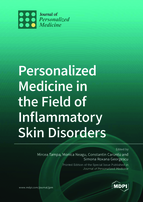Personalized Medicine in the Field of Inflammatory Skin Disorders
A special issue of Journal of Personalized Medicine (ISSN 2075-4426). This special issue belongs to the section "Mechanisms of Diseases".
Deadline for manuscript submissions: closed (31 January 2022) | Viewed by 55277
Special Issue Editors
2. Department of Dermatology, “Carol Davila” University of Medicine and Pharmacy, 37 Dionisie Lupu Street, 020021 Bucharest, Romania
Interests: dermatology; inflammation; carcinogenesis; oxidative stress
Special Issues, Collections and Topics in MDPI journals
2. Immunology Department, “Victor Babes” National Institute of Pathology, 050096 Bucharest, Romania
Interests: immuno-oncology; biomarkers; inflammation; melanoma
Special Issues, Collections and Topics in MDPI journals
Interests: physiology and physiopathology of the skin and oral mucosa; dermato-oncology; in vivo reflectance confocal microscopy
Special Issues, Collections and Topics in MDPI journals
2. Department of Dermatology, “Victor Babes” Clinical Hospital for Infectious Diseases, 283 Mihai Bravu Street, 030303 Bucharest, Romania
Interests: dermatology; psoriasis; skin infections; skin cancers; viral infections; autoimmune disorders
Special Issue Information
Dear Colleagues,
Skin inflammation is involved in a wide range of conditions that represent a major health issue worldwide. Skin and mucosal surfaces represent the primary interface between the human body and the environment, susceptible to numerous factors whose action results in diseases produced by chemical substances, mechanical trauma, microbial agents, radiation, etc. Inflammation, a complex network of interactions between soluble molecules and cells, represents the main modality of response of the skin to injuries. Numerous studies have revealed close links between chronic inflammation, oxidative stress, and carcinogenesis. Chronic inflammation induces the activation of various cell types and an increase in the production of reactive oxygen species promoting the initiation of a malignant process. Identifying specific biomarkers is essential for understanding molecular mechanisms and developing therapies appropriate to the patient’s characteristics.
Personalized medicine is an emerging field of medicine that has the potential to predict which therapy will be safe and efficacious for individual patients using an individual’s genetic profile to guide decisions regarding the diagnosis, treatment, as well as prevention of disease. Personalized medicine stratifies patients based on molecular markers and allows the identification of the best possible solution for the patient. In this respect, inflammatory skin disorders are complex afflictions with a variable course, treatment response, and unpredictable outcome and represent important candidates for a personalized approach.
The aim of this Special issue is to gather articles that present recent advancements in research involving the mechanisms that underlie the development of inflammatory skin disorders, skin and mucosal inflammation in general, as well as potential biomarkers for personalized treatment and prevention. Both clinical and basic science studies are to be considered, as we warmly invite researchers to submit original research manuscripts as well as reviews, in order to offer the readers a wider and fresher perspective of the field, updated to state-of-the-art advancements in the challenging and continuously developing area of personalized medicine in conjunction with inflammation in skin disorders.
Dr. Mircea Tampa
Dr. Monica Neagu
Prof. Dr. Constantin Caruntu
Prof. Dr. Simona Roxana Georgescu
Guest Editors
Manuscript Submission Information
Manuscripts should be submitted online at www.mdpi.com by registering and logging in to this website. Once you are registered, click here to go to the submission form. Manuscripts can be submitted until the deadline. All submissions that pass pre-check are peer-reviewed. Accepted papers will be published continuously in the journal (as soon as accepted) and will be listed together on the special issue website. Research articles, review articles as well as short communications are invited. For planned papers, a title and short abstract (about 100 words) can be sent to the Editorial Office for announcement on this website.
Submitted manuscripts should not have been published previously, nor be under consideration for publication elsewhere (except conference proceedings papers). All manuscripts are thoroughly refereed through a single-blind peer-review process. A guide for authors and other relevant information for submission of manuscripts is available on the Instructions for Authors page. Journal of Personalized Medicine is an international peer-reviewed open access monthly journal published by MDPI.
Please visit the Instructions for Authors page before submitting a manuscript. The Article Processing Charge (APC) for publication in this open access journal is 2600 CHF (Swiss Francs). Submitted papers should be well formatted and use good English. Authors may use MDPI's English editing service prior to publication or during author revisions.
Keywords
- Biomarkers of inflammation
- Viral triggers of inflammation and cancer
- Oxidative stress alterations
- Immune response profiles
- Intracellular signaling pathways in inflammation /carcinogenesis
- Support instruments for personalized medicine
- Microorganisms and inflammation
- Autoimmune disorders
- Skin conditions and systemic inflammatory diseases
- Skin manifestations of COVID-19










